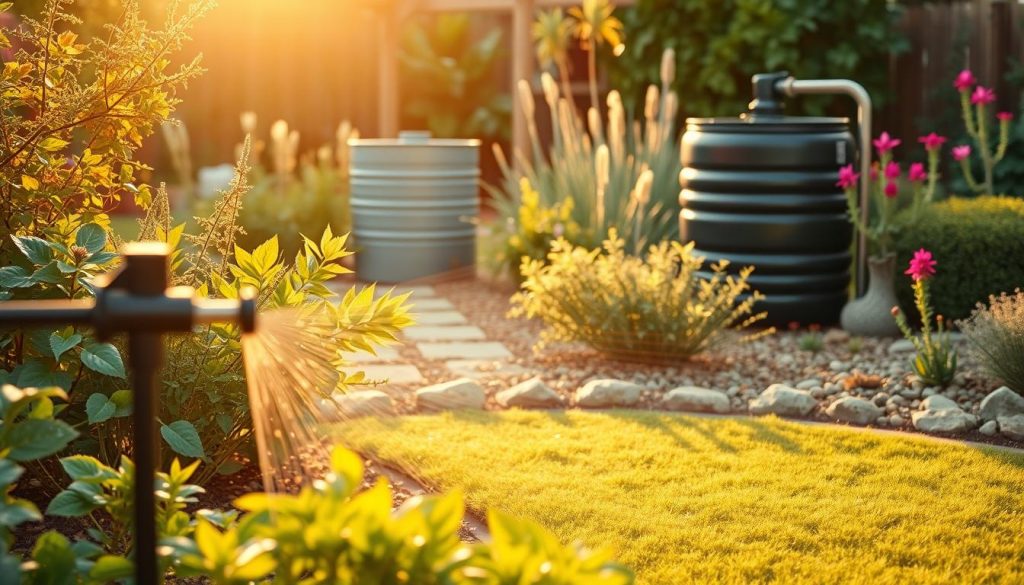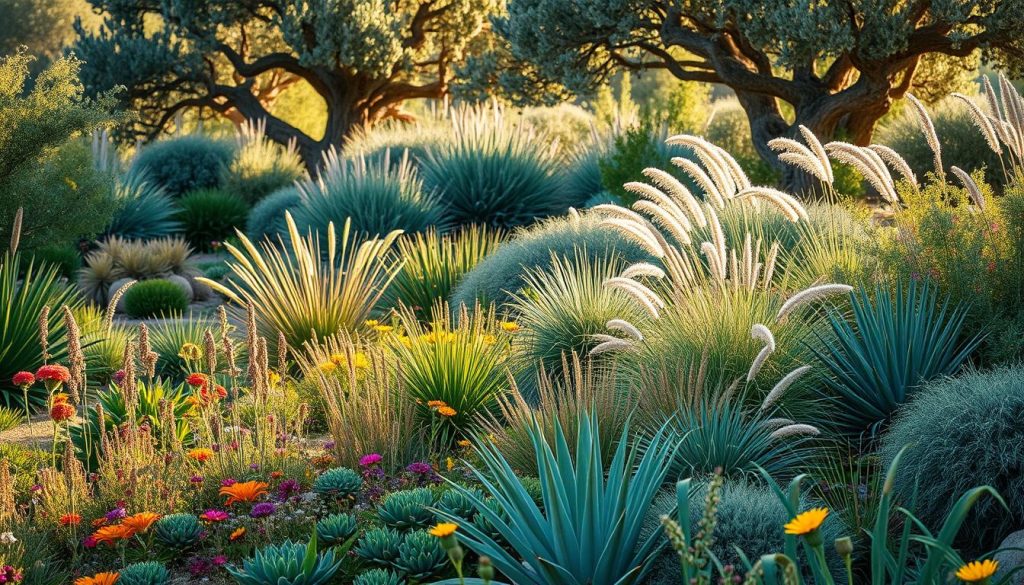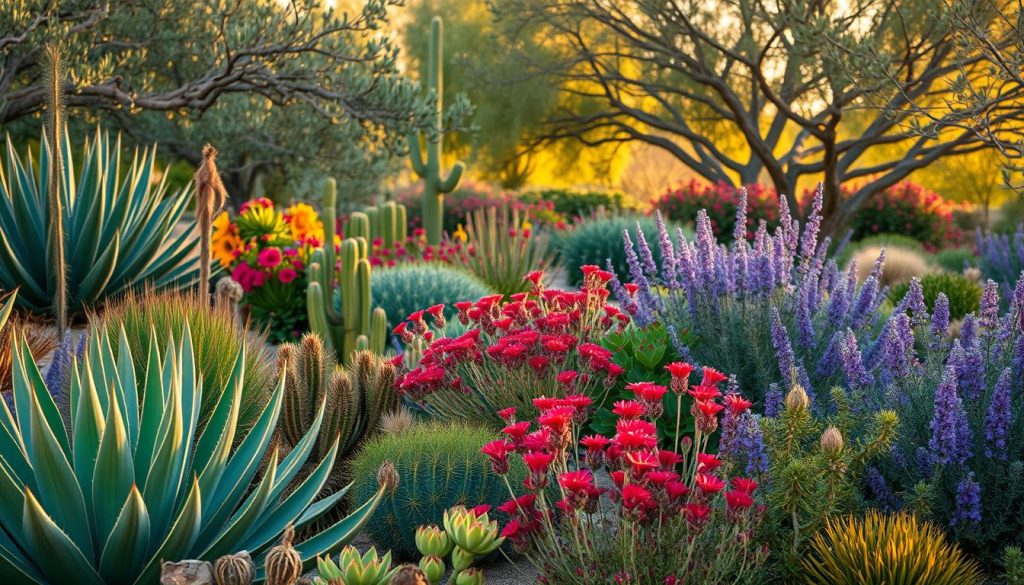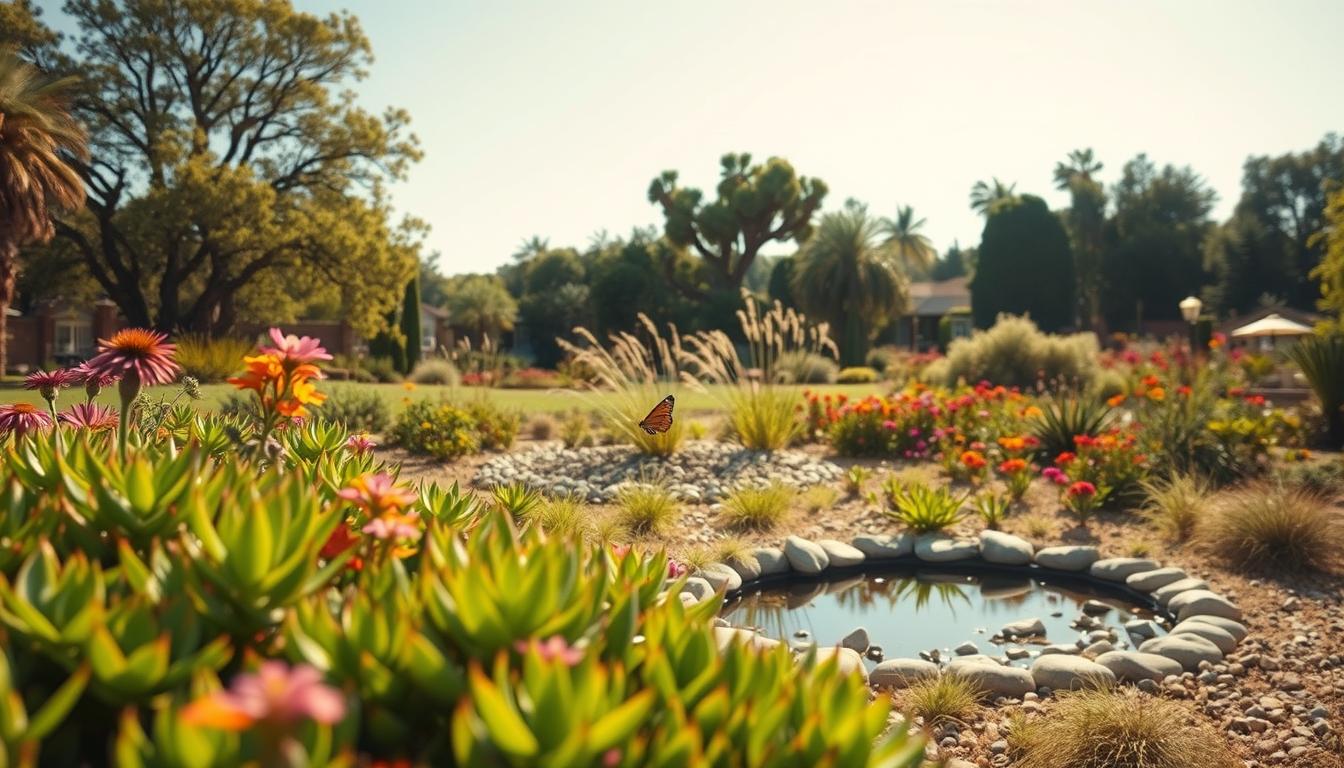Creating a stunning garden doesn’t have to drain your water supply or your wallet. As climate patterns shift and many regions face water shortages, smart landscaping choices become increasingly valuable. Your yard can thrive while using less water.
Today’s water conservation approaches go beyond cactus gardens and rock landscapes. Modern techniques allow for lush, colorful outdoor spaces that require minimal watering. These gardens often attract more wildlife and can showcase an impressive variety of textures and blooms throughout the seasons.
In this guide, we’ll explore how to select the right plants for your climate. We’ll also look at implementing efficient irrigation systems and designing your garden for maximum impact with minimal resources. Whether you’re starting from scratch or transforming an existing landscape, you’ll discover practical steps to create a beautiful outdoor space that respects our planet’s most precious resource.
The Growing Importance of Water Conservation in Home Gardens
Water-efficient gardening is now key for homeowners in the US. Our changing climate and growing population put more pressure on water. This makes it crucial to use water wisely in our gardens.
Outdoor water use in American homes is huge, at nearly 9 billion gallons daily. This shows why we need to rethink how we use water in our gardens.

Adopting water-saving landscaping is more than a trend. It’s a necessary change due to environmental shifts and limited resources. Homeowners can create stunning gardens that need less water and are easier to care for.
Climate Change and Regional Water Challenges in the US
Climate change affects water availability differently across America. The West faces long, severe droughts that have drained reservoirs and groundwater. California, Arizona, and Nevada often have to limit water use for gardens.
The Midwest and Northeast have their own water issues. They get more rain but face unpredictable weather. This makes it hard for gardens to thrive, even with enough rain.
In the Southeast, rising sea levels and saltwater intrusion into freshwater are big problems. Also, intense hurricanes can lead to water shortages during recovery.
The Environmental and Economic Impact of Traditional Gardening
Traditional landscaping focuses on lush lawns and water-loving plants, ignoring local weather. This approach is costly for the environment and our wallets.
Water Bills and Usage Statistics
Household water use is a big expense. On average, 30% of household water goes to outdoor use, like gardens. In dry areas, this can be 60-70% in summer.
| Region | Average Monthly Water Bill | Outdoor Water Usage | Potential Savings with Water-Efficient Landscaping |
|---|---|---|---|
| Northeast | $70-90 | 20-30% | $15-25 monthly |
| Southeast | $60-80 | 30-40% | $18-30 monthly |
| Midwest | $50-70 | 25-35% | $12-24 monthly |
| Southwest | $80-120 | 60-70% | $40-80 monthly |
| West Coast | $90-130 | 50-60% | $35-75 monthly |
As water gets scarcer, water companies charge more for it. This makes expensive gardens even pricier. Homeowners often see their water bills double or triple in summer.
Long-term Environmental Benefits
Water-saving gardening helps the environment in many ways. It saves water, which is good for our ecosystems and infrastructure.
Less water means less energy for treatment and distribution. The EPA says water systems use about 2% of US energy, mostly for pumping and treating.
Conserving water also protects natural habitats and watersheds. This helps fish, wildlife, and plants that depend on them. It’s vital as climate change stresses these systems.
Water-efficient gardens need fewer chemicals like fertilizers and pesticides. This reduces pollution in our waterways, protecting wildlife and people downstream.
Water-Efficient Gardening: Core Principles and Philosophy
Water-efficient gardening is more than just saving water. It’s about creating beautiful, sustainable landscapes that work well in any climate. Homeowners can make outdoor spaces that save water and look great, needing less upkeep.
This approach works with nature, not against it. It uses smart design to save water and look beautiful. When done right, these gardens support local wildlife and cut down on environmental harm.
The Seven Principles of Water-Wise Landscaping
Water-wise landscaping has seven key principles. These principles help create a garden that saves water and looks good.
- Planning and Design – Make a detailed landscape plan that thinks about water use, sun, and function.
- Soil Analysis and Improvement – Improve soil to hold more water and cut down on runoff.
- Appropriate Plant Selection – Pick plants that grow well in your area.
- Practical Turf Areas – Use grass only where it’s needed, replacing it with low-water plants elsewhere.
- Efficient Irrigation – Use drip systems and smart controllers to water plants just right.
- Mulching – Use mulch to keep water in, stop weeds, and help soil.
- Regular Maintenance – Keep up with seasonal care to save water and keep plants healthy.
| Principle | Water Savings | Implementation Cost | Maintenance Level |
|---|---|---|---|
| Planning and Design | 30-50% | Low-Medium | Low |
| Soil Improvement | 20-30% | Low | Low |
| Plant Selection | 30-60% | Medium | Low |
| Practical Turf Areas | 40-70% | Medium-High | Very Low |
| Efficient Irrigation | 25-40% | Medium | Low-Medium |
Balancing Aesthetics with Sustainability
Many think water-efficient gardens are dull or desert-like. But they can be lush, colorful, and stunning. The secret is in the design, which includes varied textures and seasonal interest.

By using different plant heights and adding hardscape, water-efficient gardens can be as beautiful as traditional ones. Many drought-tolerant plants have amazing blooms and interesting foliage, making the garden change with the seasons.
Success Stories from American Homeowners
The Thompson family in Arizona turned their lawn into a xeriscape, saving 65% of water. They now have a pollinator haven. “We enjoy our garden more,” says Sarah Thompson. “The hummingbirds and butterflies are a surprise.”
In Michigan, the Jacobsens made their yard a water-efficient landscape with native plants and rain gardens. They now catch 95% of rainfall, cutting down on runoff. Their maintenance time went from 120 hours to 40 hours a year.
The Martinez family in California changed their garden to a Mediterranean style. Even with droughts, their garden stayed vibrant. Their water bills fell by 70%, and they only spend a weekend a month on upkeep.
Planning Your Water-Efficient Garden Layout
A well-planned garden is key to saving water and looking great. Before buying plants or irrigation, design your space carefully. This saves water and maintenance time.
Smart planning lets your garden thrive with little water. It meets your needs for beauty and function.
Analyzing Your Space and Regional Microclimates
Start by analyzing your garden site. Walk it at different times to see sun patterns. Note areas with full sun, partial shade, or deep shade.
Also, watch for wind spots. Wind can make plants lose moisture faster.
Check your soil type by digging small holes. Clay holds water but can get soggy. Sandy soil drains fast but needs more water.
Every garden has microclimates. These are small areas with unique conditions. They might include:
- Heat-trapping south-facing walls
- Cool, shaded northern exposures
- Low spots where water naturally collects
- Areas sheltered from wind by structures or large plants
- Reflective zones near windows or light-colored surfaces
Map these microclimates to place plants where they’ll thrive. For example, put moisture-loving plants in low spots. Heat-tolerant plants do well near reflective surfaces.
Hydrozoning: Grouping Plants by Water Requirements
Hydrozoning groups plants by their water needs. This prevents overwatering or underwatering. It ensures each area gets the right amount of water.
Divide your garden into three or four hydrozones:
- Oasis Zone: Areas near entry points or patios for visual impact
- Moderate Zone: Plants needing occasional water during dry times
- Low-Water Zone: Plants that need little water
- No-Water Zone: Plants that survive on rain alone
Creating Functional and Beautiful Designs
Water-efficient gardens can be stunning and practical. Identify how you use your outdoor space. Think about dining, play, gardening, or relaxation areas.
Consider reducing lawn areas. They use a lot of water. Replace them with patios, play areas, or diverse plants that save water.
Hardscaping Elements
Good hardscaping reduces water needs and adds beauty. Permeable patios let rainwater soak into the ground. Dry creek beds are attractive and help with drainage.
Rain gardens capture runoff and let it soak into the soil. They support local wildlife and turn waste into a resource.
Pathways and Water Features
Well-designed pathways protect plants and prevent soil damage. Use permeable materials like gravel or special pavers.
Water features can fit into water-efficient gardens. Recirculating fountains or small ponds use little water. They attract wildlife and add to the garden’s beauty.
Selecting Drought-Tolerant Plants for Maximum Impact
Starting a vibrant, water-saving garden means picking the right plants. Choose plants that match your area and conditions. These plants use less water and need less care, making your garden beautiful and easy to maintain.
These plants have special features like deep roots or waxy leaves. They help them grow well even when it’s dry.
Choosing the right plants makes your garden look great, not just survive. Pick plants that fit your local weather, soil, and temperature. This way, they’ll do well, not just get by.
Native American Species by Region
Native plants are great for water-saving gardens. They’ve grown in your area for thousands of years. They need less water, food, and care, and help local animals and bees.

The West Coast has many drought-tolerant native plants. California poppy blooms brightly with little water. Manzanita has striking red bark and stays green all year. California lilac blooms blue in spring and helps prevent fires.
Midwest and Eastern Options
The Midwest and East also have drought-tolerant natives for dry summers. Purple coneflower attracts butterflies and grows in poor soil. Black-eyed Susan flowers yellow all summer and fall. Little bluestem grass turns copper-red in autumn.
Southern Climate Favorites
Southern gardens face hot and humid challenges. Yucca plants have tall leaves and flowers. Lantana blooms all summer and tolerates dry soil. Pink muhly grass turns pink in fall.
Ornamental Grasses and Perennials
Ornamental grasses are key to water-saving gardens. They add movement and interest all year. Grasses like feather reed and fountain grass need little water and grow tall.
Perennials like Russian sage, yarrow, and sedum bloom year-round. They have deep roots that find water even when it’s dry. They’re perfect for gardens that save water.
Drought-Resistant Trees and Shrubs
Woody plants are the backbone of water-saving landscapes. They provide shade and reduce water loss. Desert willow blooms in hot weather. Smoke bush has purple leaves and interesting texture. Juniper trees stay green all year and thrive in tough conditions.
When picking trees and shrubs, think about their size. The right plants can create cool spots for other plants. This saves water and makes your garden more interesting.
Xeriscaping: Beyond Desert Landscapes
Xeriscaping is more than just desert gardens. It’s a way for homeowners in America to make stunning landscapes, no matter the climate. This method combines beauty with practicality, working with nature instead of fighting it. Despite its growing popularity, many still don’t understand xeriscaping.
Debunking Common Misconceptions About Xeriscaping
When people think of xeriscaping, they often picture empty yards with cacti. But this isn’t true. The word “xeri” means “dry,” not “desert.” It’s about choosing the right plants and using water wisely.
Some common myths about xeriscaping include:
- It requires eliminating all grass and traditional plants
- Xeriscaped gardens look barren and uninviting
- It only works in hot, arid climates
- Xeriscaping means replacing plants with rocks and gravel
- These gardens require no maintenance
Actually, xeriscaping is about creating beautiful landscapes that need little water. These gardens can have lush plants, ornamental grasses, and even some turf. They’re designed to be beautiful and water-efficient.

Adapting Xeriscaping Principles to Different US Climates
Xeriscaping is flexible and adaptable. The core principles stay the same, but how you apply them changes with the local climate. In the Pacific Northwest, for example, you might use native ferns and plants that love moisture in shaded areas. In sunnier spots, drought-tolerant plants work best.
In New England, xeriscaping gardens often feature native woodland plants that do well with natural rainfall. The Rocky Mountains have xeriscaped gardens with plants adapted to high altitudes, needing little water. Even in humid areas like the Gulf Coast, xeriscaping helps gardens survive both wet and dry seasons.
Successful Xeriscaping Examples from Across America
Homeowners across the country are seeing great results with xeriscaping. In Colorado, a family turned their lawn into a colorful meadow with native wildflowers and grasses. This cut their water use by 60% and reduced maintenance time by half.
In Seattle, a homeowner created a xeriscape with native plants like salal and sword ferns. The garden mostly relies on rain, needing water only during the driest summer weeks.
In suburban Atlanta, a family has a xeriscape garden that looks formal but uses much less water. It has native plants like black-eyed Susans and coneflowers, arranged to look good and save water.
These examples show xeriscaping isn’t just one style. It’s a flexible approach that can fit any property, preference, or climate. By working with nature, homeowners across America are making beautiful, eco-friendly landscapes.
Smart Irrigation Techniques for Optimal Water Usage
Today, gardeners are using smart irrigation to save water. New technology lets us water our gardens with precision. This saves water and keeps plants healthy.
With the right tools, you can cut your water use by up to 50%. This is compared to old sprinkler systems. You can still have a beautiful garden.
Modern Drip Irrigation Systems
Drip irrigation is a big step forward in saving water. It sends water straight to the roots. This cuts down on evaporation and runoff.
Different areas of your garden need different parts:
- Drip emitters: Perfect for individual plants, delivering water at rates from 0.5 to 4 gallons per hour
- Soaker hoses: Ideal for rows of plants or dense garden beds
- Micro-sprayers: Best for ground covers and areas with clustered plantings
Setting up these systems is easy, even for DIY fans. The cost usually pays off in two growing seasons, thanks to lower water bills.
Smart Controllers and Weather-Based Sensors
Old timers that water all the time are outdated. Smart irrigation controllers adjust based on weather. They make watering smarter.
These systems use real-time data for better watering:
- Soil moisture sensors that prevent watering when the ground already contains adequate moisture
- Weather stations that monitor rainfall, temperature, and humidity
- ET (evapotranspiration) controllers that calculate plant water needs based on local climate data
Upgrading to smart controllers can cut outdoor water use by 15-30%. They cost more than basic timers but save water and are convenient.
Efficient Watering Schedules by Season and Region
Even the best systems need a good schedule. A plan that changes with the seasons and your climate ensures plants get what they need.
Morning vs. Evening Watering
When you water matters a lot. Morning watering (5-9 AM) is best because:
- Lower wind speeds reduce evaporation
- Plants have access to moisture during peak daytime growth
- Foliage has time to dry, reducing fungal disease risk
In very hot, dry places, evening watering (after 4 PM) works well. But in humid areas, it can lead to disease because leaves stay wet.
Adjusting for Seasonal Changes
Your watering needs change a lot throughout the year. A good schedule should:
- Spring: Gradual increase in frequency as temperatures rise and plants establish
- Summer: Deep, infrequent watering to encourage drought resistance
- Fall: Reduced frequency as temperatures cool and growth slows
- Winter: Minimal watering in most regions, with occasional moisture for evergreens
Good irrigation is about using water wisely. It’s not just about using less. By watering right, your garden will thrive and save water.
Soil Amendments and Mulching Strategies
Improving your garden’s water use starts with the soil and mulching. Many focus on plants and water, but soil and mulching are key. They help your garden use less water.
Building Water-Retentive Soil for Your Climate
Your soil’s type affects how well it holds water. Sandy soils drain fast, while clay soils can be too wet. Knowing your soil type is the first step to improve it.
For sandy soils, add compost, aged manure, or coconut coir. These create pockets that hold water but let it drain. Add 2-3 inches of compost each year to change your soil.
Clay soils need different help. Gypsum breaks up clay without changing pH. Adding composted bark helps water move while keeping moisture.
Organic vs. Inorganic Mulch Options
The right mulch is key for water efficiency. Organic and inorganic mulches have different benefits for your garden.
| Mulch Type | Water Retention | Longevity | Best Uses | Climate Considerations |
|---|---|---|---|---|
| Wood Chips | Excellent | 1-3 years | Shrub beds, trees | All climates; decomposes faster in humid areas |
| Straw | Good | 3-6 months | Vegetable gardens | Dry climates; can become moldy in wet regions |
| Gravel/Stone | Poor | Permanent | Pathways, desert gardens | Hot climates; can increase ambient temperature |
| Pine Needles | Moderate | 1-2 years | Acid-loving plants | Works in most climates; excellent for slopes |
| Compost | Very Good | 6-12 months | Annual beds, vegetables | All climates; adds nutrients as it breaks down |
Application Techniques for Maximum Water Conservation
How you apply mulch matters a lot. Start with clean, prepared soil. Water deeply before adding mulch to keep moisture in.
Leave space around plants to prevent disease. This lets air in while keeping water in the soil.
Proper Mulch Depth
Depth matters for mulch. Wood chips or bark need 3-4 inches. Compost or leaf mold works with 1-2 inches.
A thin layer won’t stop weeds or hold water. Too much can block water, making it hard for plants to get what they need.
Seasonal Maintenance
Replace organic mulch every year. Fall is best in most places. It protects roots and adds nutrients in spring.
Fluff mulch to stop water from running off. This keeps your mulch working well all year, saving water.
Rainwater Harvesting Systems for Home Gardens
Capturing rainwater for your garden is a smart move. It’s a free resource that can cut down your water bills. Plus, it gives plants the soft, chlorine-free water they love. Even with moderate rainfall, a good system can collect thousands of gallons a year.
Simple Collection Methods for Any Budget
You don’t need to spend a lot to start harvesting rainwater. Just place rain barrels under downspouts to catch roof runoff. A 55-gallon barrel costs $50-$100 and can fill up in one rain.
If you’re ready to spend a bit more, you can link barrels together. This increases storage without needing a lot of space. To figure out how much water you can collect, use this formula: 1 inch of rain on 1,000 square feet of roof equals about 600 gallons.
Storage Solutions and Filtration Systems
There are many storage options, from decorative barrels to large tanks. Above-ground tanks are easy to install and access. Underground cisterns save space and keep water from freezing in cold climates.
Filtration is key to keeping water clean. First-flush diverters get rid of the first runoff, which has most contaminants. For even cleaner water, add mesh screens and sediment filters to prevent clogs in irrigation systems.
Integrating Harvested Water into Your Irrigation Plan
Connecting your rainwater to your garden can be simple or complex. Gravity-fed systems work well for raised beds. For wider coverage, small pumps can power drip irrigation or soaker hoses.
Many gardeners mix methods. They use automated systems for regular watering and hand-watering for special plants. This mix of methods saves water and keeps flexibility.
Legal Considerations by State
Before setting up a rainwater collection system, check local laws. Most states support rainwater harvesting, but some have rules. Colorado and Utah used to limit it, but new laws have eased those rules. Texas and Arizona offer tax breaks for installing systems.
DIY vs. Professional Installation
Basic setups are great DIY projects. They need little tools and know-how. But, more complex systems might need a pro. Think about your plumbing and electrical skills before deciding.
For most, a mix of DIY and professional work is best. Start simple and grow your system as you learn. This way, you save water right away and learn what works for your garden.
Transform Your Landscape: Taking the First Steps Toward Water-Efficient Beauty
Starting your water-efficient gardening journey is easy. Begin with small, manageable changes that make a big difference. Try replacing a section of thirsty lawn with native plants or adding mulch to beds to cut down on evaporation.
Spring is great for planning and picking plants. Fall is perfect for planting drought-tolerant plants. Summer helps you see which parts of your yard need the most help with heat.
Worried about the cost? Start with simple, yet effective changes like adjusting your irrigation schedule or using rain barrels. Break down bigger projects into smaller ones, focusing on one area at a time.
If HOA rules are a concern, focus on neat designs that show off water conservation. Many communities are updating their rules to support sustainable gardening as water becomes scarcer.
Every gallon saved counts. If 10% of American homeowners used basic water-saving techniques, we could save billions of gallons a year. This would also make our landscapes more resilient.
Water-efficient gardening helps us connect with nature and our local heritage. As you change your garden, you’ll find it needs less care and resources. It will also be more beautiful and fulfilling than traditional gardens.

